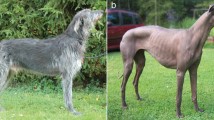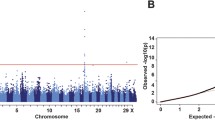Abstract
Sabino (SB) is a white spotting pattern in the horse characterized by white patches on the face, lower legs, or belly, and interspersed white hairs on the midsection. Based on comparable phenotypes in humans and pigs, the KIT gene was investigated as the origin of the Sabino phenotype. In this article we report the genetic basis of one type of Sabino spotting pattern in horses that we call Sabino 1, with the alleles represented by the symbols SB1 and sb1. Transcripts of KIT were characterized by reverse transcriptase polymerase chain reaction (RT-PCR) and sequencing cDNA from horses with the genotypes SB1/SB1, SB1/sb1, and sb1/sb1. Horses with the Sabino 1 trait produced a splice variant of KIT that did not possess exon 17. Genomic DNA sequencing of KIT revealed a single nucleotide polymorphism (SNP) caused by a base substitution for T with A in intron 16, 1037 bases following exon 16. The SNP associated with SB1 was designated KI16+1037A. This substitution eliminated a MnlI restriction site and allowed the use of PCR-RFLP to characterize individuals for this base change. Complete linkage was observed between this SNP and Sabino 1 in the Tennessee Walking Horse families (LOD = 9.02 for Θ = 0). Individual horses from other breeds were also tested. All five horses homozygous for this SNP were white, and all 68 horses with one copy of this SNP either exhibited the Sabino 1 phenotype or were multipatterned. Some multipatterned individuals appeared white due to the additive effect of white spotting patterns. However, 13 horses with other Sabino-type patterns did not have this SNP. Based on these results we propose the following: (1) this SNP, found within intron 16, is responsible for skipping of exon 17 and the SB1 phenotype, (2) the White and Sabino phenotypes are heterogeneous and this mechanism is not the only way to produce the pattern described as “Sabino” or “White,” and (3) homozygosity for SB1 results in a complete or nearly completely white phenotype.



Similar content being viewed by others
References
Andre C, Martin E, Cornu F, Hu WX, Wang XP, et al. (1992) Genomic organization of the human c-kit gene: evolution of the receptor tyrosine kinase subclass III. Oncogene 7(4), 685–691
Bowling AT (1987) Equine linkage group II: phase conservation of To with AlB and GcS. J Hered 78(4), 248–250
Brooks SA, Terry RB, Bailey E (2002) A PCR-RFLP for KIT associated with tobiano spotting pattern in horses. Anim Genet 33(4), 301–303
Duttlinger R, Manova K, Chu TY, Gyssler C, Zelenetz AD, et al. (1993) W-sash affects positive and negative elements controlling c-kit expression: ectopic c-kit expression at sites of kit-ligand expression affects melanogenesis. Development 118(3), 705–717
Geissler EN, Russell ES (1983) Analysis of the hematopoietic effects of new dominant spotting (W) mutations of the mouse. II. Effects on mast cell development. Exp Hematol 11(6), 461–466
Geurts R (1977) Hair Colour in the Horse. (Canaan, NY: Sporting Book Center, Inc.)
Gower J (1999) Horse Color Explained. (North Pomfret, VT: Trafalgar Square Publishing)
Ito M, Kawa Y, Ono H, Okura M, Baba T, et al. (1999) Removal of stem cell factor or addition of monoclonal anti-c-KIT antibody induces apoptosis in murine melanocyte precursors. J Invest Dermatol 112(5), 796–801
Lauridsen C, D’Alberti T, Robinson P (2000) Shapiro and Senapathy Splice Score: An Applet. http://home. snafu.de/probins/Splice/splice.html
Locke M, Penedo M, Bricker S, Million L, Murray J (2002) Linkage of the grey coat color locus to microsattellites on horse chromosome 25. Anim Genet 33(5), 329–337
Mackenzie MA, Jordan SA, Budd PS, Jackson IJ (1997) Activation of the receptor tyrosine kinase Kit is required for the proliferation of melanoblasts in the mouse embryo. Dev Biol 192(1), 99–107
Mariat D, Taourit S, Guerin G (2003) A mutation in the MATP gene causes the cream coat colour in the horse. Genet Sel Evol 35(1), 119–133
Marklund S, Kijas J, Rodriguez-Martinez H, Ronnstrand L, Funa K, et al. (1998) Molecular basis for the dominant white phenotype in the domestic pig. Genome Res 8(8), 826–833
Marklund S, Moller M, Sandberg K, Andersson L (1999) Close association between sequence polymorphism in the KIT gene and the roan coat color in horses. Mamm Genome 10(3), 283–288
Mau C, Poncet A, Bucher B, Stranzinger G, Rieder S (2004) Genetic mapping of dominant white (W), a homozygous lethal condition in the horse (Equus caballus). J Anim Breed Genet 121(6), 374–383
Mayer TC (1973) The migratory pathway of neural crest cells into the skin of mouse embryos. Dev Biol 34(1), 39–46
Metallinos DL, Bowling AT, Rine J (1998) A missense mutation in the endothelin-B receptor gene is associated with Lethal White Foal Syndrome: an equine version of Hirschsprung disease. Mamm Genome 9(6), 426–431
Nocka K, Tan JC, Chiu E, Chu TY, Ray P, et al. (1990) Molecular bases of dominant negative and loss of function mutations at the murine c-kit/white spotting locus: W37, Wv, W41 and W. EMBO J 9(6), 1805–1813
Peters EM, Tobin DJ, Botchkareva N, Maurer M, Paus R (2002) Migration of melanoblasts into the developing murine hair follicle is accompanied by transient c-Kit expression. J Histochem Cytochem 50(6), 751–766
Pielberg G, Olsson C, Syvanen AC, Andersson L (2002) Unexpectedly high allelic diversity at the KIT locus causing dominant white color in the domestic pig. Genetics 160(1), 305–311
Pulos WL, Hutt FB (1969) Lethal dominant white in horses. J Hered 60(2), 59–63
Rousset D, Agnes F, Lachaume P, Andre C, Galibert F (1995) Molecular evolution of the genes encoding receptor tyrosine kinase with immunoglobulinlike domains. J Mol Evol 41(4), 421–429
Santschi EM, Purdy AK, Valberg SJ, Vrotsos PD, Kaese H, et al. (1998) Endothelin receptor B polymorphism associated with lethal white foal syndrome in horses. Mamm Genome 9(4), 306–309
Shapiro MB, Senapathy P (1987) RNA splice junctions of different classes of eukaryotes: sequence statistics and functional implications in gene expression. Nucleic Acids Res 15(17), 7155–7174
Sponenburg DP (2003) Equine Color Genetics, 2nd ed. (Ames, IA: Iowa State University Press)
Spritz RA (1994) Molecular basis of human piebaldism. J Invest Dermatol 103(5 Suppl), 137S–140S
Syrris P, Heathcote K, Carrozzo R, Devriendt K, Elcioglu N, et al. (2002) Human piebaldism: six novel mutations of the proto-oncogene KIT. Hum Mutat 20(3), 234
Terry RB, Archer S, Brooks S, Bernoco D, Bailey E (2004) Assignment of the appaloosa coat colour gene (LP) to equine chromosome 1. Anim Genet 35(2), 134–137
Venta PJ, Brouillette JA, Yuzbasiyan-Gurkan V, Brewer GJ (1996) Gene-specific universal mammalian sequence-tagged sites: application to the canine genome. Biochem Genet 34(7–8), 321–341
Wiersema J (1961a) De haarkleur der paarden I. Paard 28(17), 1–6
Wiersema J (1961b) De haarkleur der paarden III. Paard 29(6), 2–4
Wiersema J (1961c) De haarkleur der paarden IV. Paard 28(10), 5–6
Author information
Authors and Affiliations
Corresponding author
Rights and permissions
About this article
Cite this article
Brooks, S.A., Bailey, E. Exon skipping in the KIT gene causes a Sabino spotting pattern in horses. Mamm Genome 16, 893–902 (2005). https://doi.org/10.1007/s00335-005-2472-y
Received:
Accepted:
Published:
Issue Date:
DOI: https://doi.org/10.1007/s00335-005-2472-y




